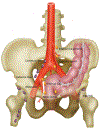Rectal cancer lexicon: consensus statement from the society of abdominal radiology rectal & anal cancer disease-focused panel
- PMID: 31388697
- PMCID: PMC6824987
- DOI: 10.1007/s00261-019-02170-5
Rectal cancer lexicon: consensus statement from the society of abdominal radiology rectal & anal cancer disease-focused panel
Abstract
Standardized terminology is critical to providing consistent reports to referring clinicians. This lexicon aims to provide a reference for terminology frequently used in rectal cancer and reflects the consensus of the Society of Abdominal Radiology Disease Focused Panel in Rectal cancer. This lexicon divided the terms into the following categories: primary tumor staging, nodal staging, treatment response, anal canal anatomy, general anatomy, and treatments.
Keywords: Lexicon; MRI; Rectal cancer; Society of Abdominal Radiology Rectal & Anal Cancer Disease-Focused Panel; Staging.
Conflict of interest statement
Figures





References
-
- Weiser MR. AJCC 8th Edition: Colorectal Cancer. Annals of surgical oncology. 2018;25:1454–1455. - PubMed
-
- Al-Sukhni E, Milot L, Fruitman M, et al. Diagnostic accuracy of MRI for assessment of T category, lymph node metastases, and circumferential resection margin involvement in patients with rectal cancer: a systematic review and meta-analysis. Annals of surgical oncology. Springer-Verlag. 2012;19:2212–2223. - PubMed
-
- Horvat N, Petkovska I, Gollub MJ. MR Imaging of Rectal Cancer. Radiol Clin North Am. 2018;56:751–774. - PubMed
-
- Beets-Tan RGH, Lambregts DMJ, Maas M, et al. Magnetic resonance imaging for the clinical management of rectal cancer patients: recommendations from the 2012 European Society of Gastrointestinal and Abdominal Radiology (ESGAR) consensus meeting Eur Radiol. Springer Berlin Heidelberg; 2013. pp. 2522–2531. - PubMed
-
- MERCURY Study Group. Extramural depth of tumor invasion at thin-section MR in patients with rectal cancer: results of the MERCURY study. Radiology. 2007;243:132–139. - PubMed

